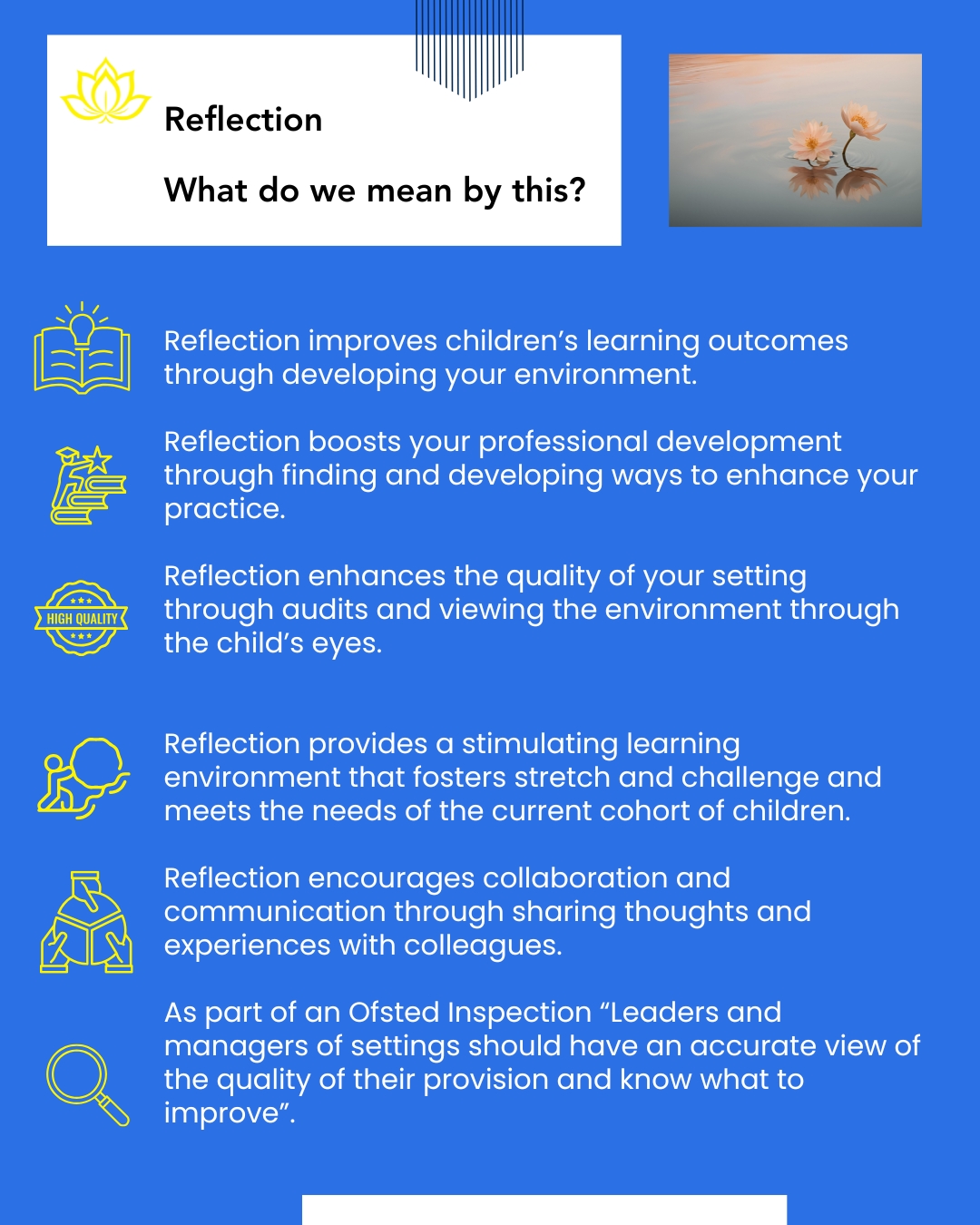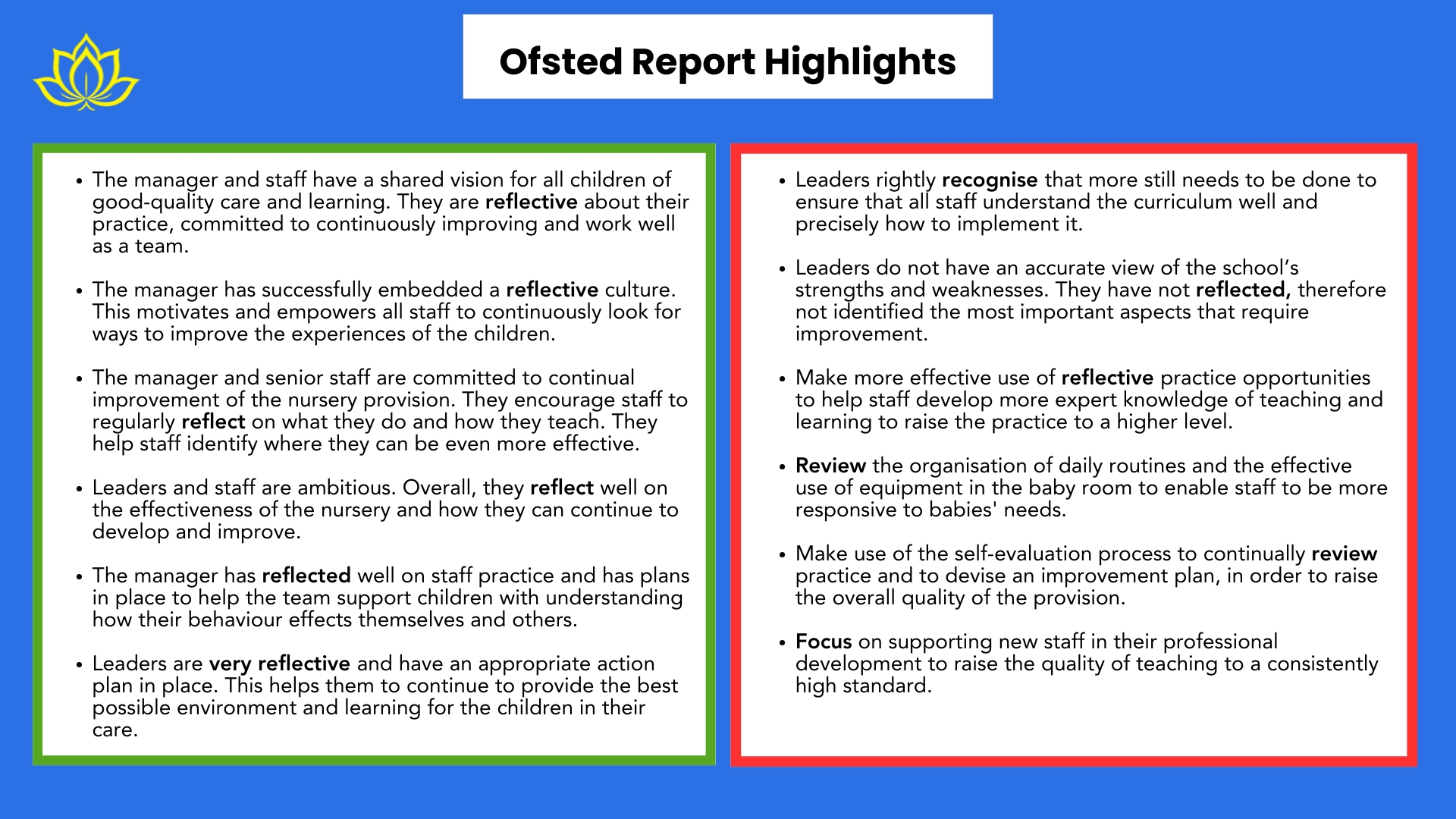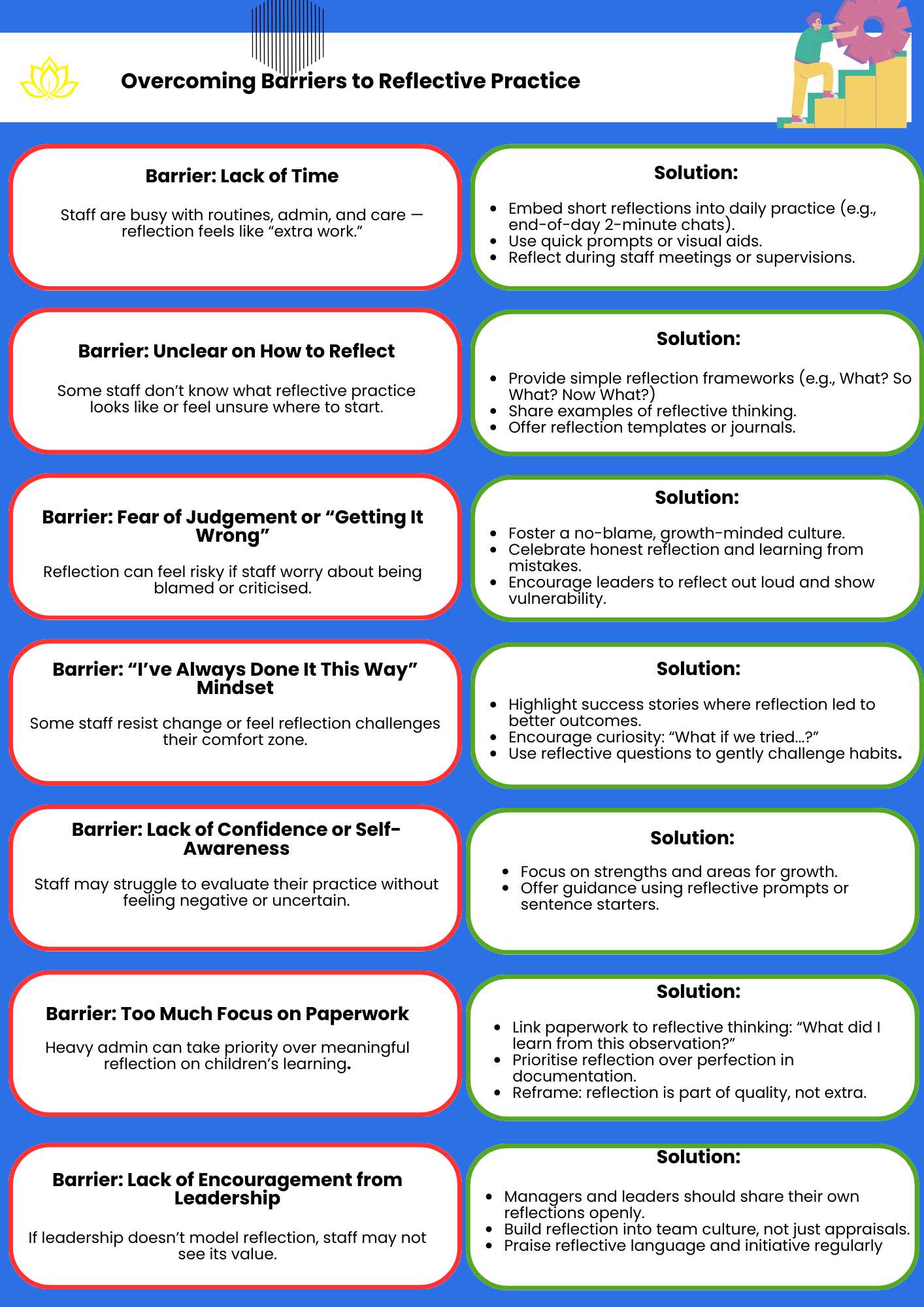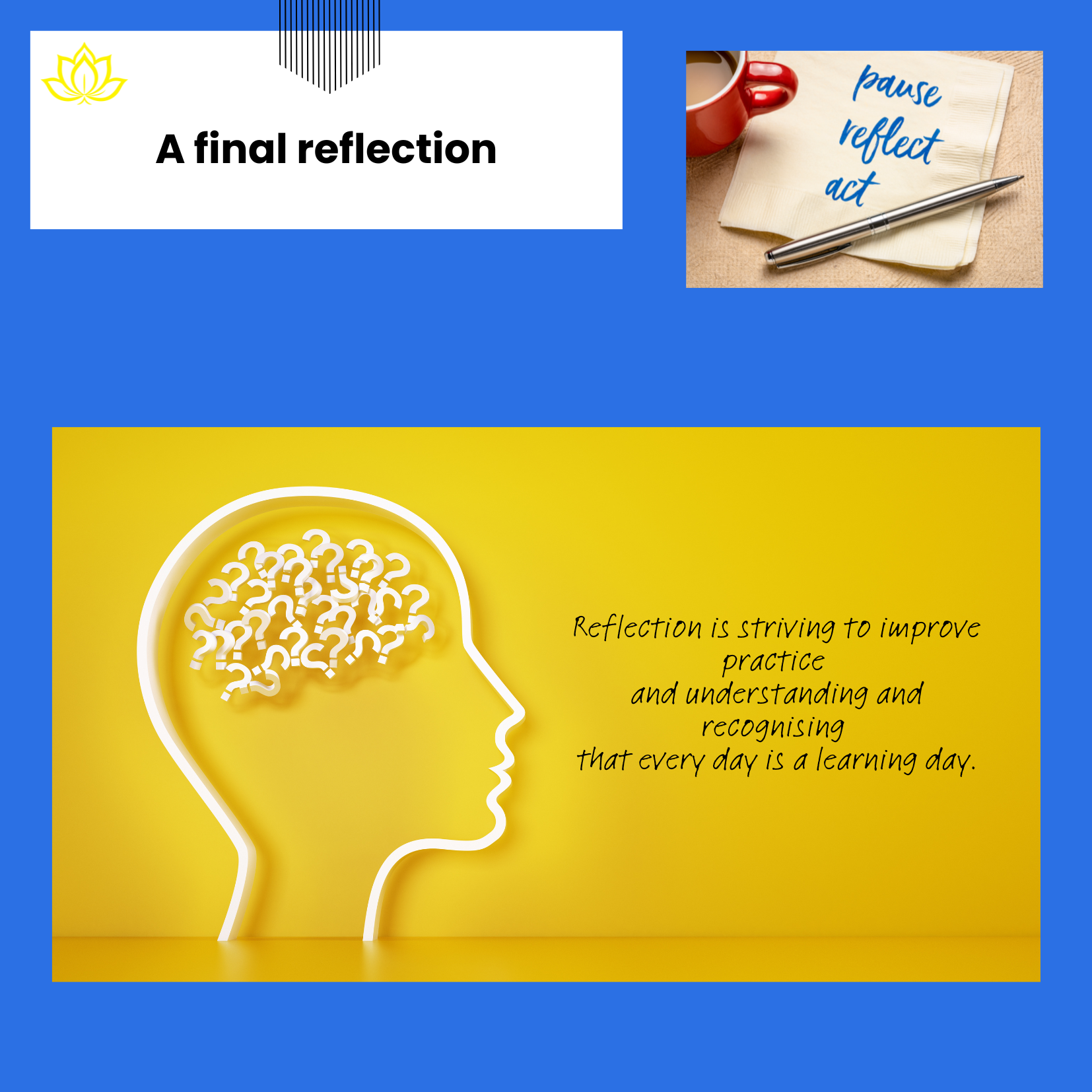A setting who gets this right will…
- Constantly be reflecting as a whole and making impactful changes in a timely manner.
- Have staff that celebrate their strengths.
- Have staff that are always looking to improve the quality of their own practice and acknowledges areas that need developing too.
- Consider the impact of their practice on the children and families.
- Seek out and listen to new ideas and different ways of working.
“We do not learn from experience… we learn from reflecting on experience.” – John Dewey
In the fast-paced world of early years education, it’s easy to move from one moment to the next without pausing to think about what just happened. But it’s in that pause—where we reflect—that true growth begins. Reflection helps us make sense of our practice, understand children more deeply, and continually improve the way we teach and support learning. It allows us to celebrate what’s working, question what isn’t, and make intentional choices moving forward. For early years professionals, reflection isn’t an add-on—it’s an essential tool for delivering high-quality, responsive care and education.

Why does it matter?
Reflective practice is a powerful tool for improving outcomes—not just for children, but for practitioners and the setting as a whole. When we reflect, we’re able to develop our environment with intention, ensuring it is well-planned and resourced to have the greatest possible impact on children’s learning, engagement, and behaviour. It supports professional growth by encouraging us to explore new ways of doing things, enhance our practice, and continually adapt to meet the unique needs of our current cohort.
Regular reflection also raises the overall quality of the setting, helping to create rich, stimulating environments that offer both stretch and challenge. It fosters a culture of collaboration and communication, where team members feel empowered to share their thoughts, ideas, and experiences. This exchange not only promotes consistency and creativity but also strengthens team confidence and cohesion.
From a regulatory perspective, reflection plays a vital role in preparation for Ofsted inspections. Inspectors look for evidence that leaders and managers have a clear, accurate understanding of the quality of their provision and are actively working to improve or sustain high standards. In short, reflection is what turns experience into insight—and insight into action.
What are the benefits of Reflection?

What do Ofsted Reports capture?

How engaged are you in reflection now, is it consistent across your team?
When did you last reflect?
Task One – Time for some reflection
Thinking about your current practice, which of these 4 matches your level of reflection in your practice.
- Reflection on the environment is continuous, timely, and impactful.
- Regular reflection on and critical reviews of the environment to optimise it for all.
- There is only occasional reflection on the environment to enhance it.
- Any reflection on the environment is rare.
Share your perspective on this with your team and be honest with them (and yourself)!
Now for a bit more reflection….
Task Two – Questions to direct your focus
On your own or with a colleague answer the questions below……
- How often do you reflect on the child’s environment either personally or as a team?
Thinking of the space generally:
- Set up of the room/area whatever your focus is
- Are there any areas of the room that are not being used
- Are there any blind spots in the classroom where you can’t see the children – think ‘windscreen‘.
- Do you station yourself accordingly in the environment to maintain safety and awareness of children’s whereabouts at all time?
- Are children reliant on adults to lift things down from teacher high shelves or is everything at the child’s level?
- Think age appropriate – can the children lift the basket of building blocks off the shelf without dropping it because it is too heavy for them to carry?
Why might changes be needed in your environment and how can reflection help?
Repeated accidents in certain areas? (Do you audit your accident reports periodically to detect patterns?)
Reflection encourages you to look beyond the surface of incidents and ask why they’re happening. By auditing accident reports and observing patterns, practitioners can identify hazards or environmental triggers (e.g., overcrowded spaces, unclear boundaries, unsuitable equipment) and make informed changes to improve safety and prevent future accidents.
Children are not engaging in certain areas of the room.
A reflective practitioner doesn’t just accept disinterest—they ask why. Is the area too cluttered? Are the resources developmentally appropriate? Does it connect to children’s interests? Through regular reflection, you can trial new setups, rotate materials, or reposition furniture to make spaces more inviting and relevant.
Your environment doesn’t meet the current cohort of children’s needs.
Each group of children is different—and reflection helps you stay in tune with their evolving needs. It supports ongoing adaptation of the environment, routines, and resources so that the setting remains responsive. Rather than sticking to a one-size-fits-all approach, reflection ensures your provision is flexible, intentional, and child-led.
Things are constantly being dropped or thrown on the floor.
When children frequently drop or throw materials, reflection helps you explore the root cause: is it sensory-seeking behaviour? Is the activity not engaging enough? Are expectations clear? Reflecting on these behaviours can lead to proactive adjustments—like offering more hands-on, heavy work activities, or changing how materials are presented—to meet children’s needs in more constructive ways.
How to make these changes…
- Observe – what is happening at a surface level. Place yourself at a child’s level in the room and view the room and learning opportunities from their height. Consider a room audit – available on line.
- Discuss your findings and ask for the team for their thoughts.
- Create an action/development plan – short, medium and long term.
- Agree what immediate changes can be implemented as a team.
- Evaluate and reflect on the effectiveness of the changes.
- Repeat.
Use Team meetings and Inset days for deeper discussions around these items
There will be barriers, here’s how to overcome them…

A little bit of theory
Schön
Schön (1983) introduced two types of reflection:
Reflection-on-Action: Looking back on events after they have occurred. This is a process where you learn from the experience highlighting the success and working out what you would do differently in that moment next time or what you can do to further or enhance the above. How does this work in practice?
Reflection-in-Action: Making decisions in the moment, bringing together all the information available to a practitioner at that moment to make a decision about the best course of action. This is often known as as ‘thinking on one’s feet’.
In practice: Reflection-in-action:
You are in the construction area with the children, you assess and respond to children’s needs by talking to the children about magnets as one of them discovers the magnetic tiles have stuck to a teapot that was in the home corner.
In practice: Reflection-on-action:
After the end of the day, you review your decisions and plan improvements and add further resources to stretch and challenge the children’s learning.
Through consistent reflection you will develop a deeper understanding of your practice and your setting, make more informed decisions, which will lead to providing a higher level of care and education for the children in your setting.
EDAR approach
Experience: an event or incident which you would like to change or improve
Describe: aspects such as who was involved, what happened, when it happened and where it happened
Analyse: Consider the experience more deeply and ask yourself how it happened and why it happened
Revise: think about how you would do it differently if it happened again, and then try this out if you have the opportunity
Stories from the frontline
Reflection One
A child who started the nursery at age 3 with no experience of attending a setting previously who was very energetic. Initially attended the afternoon sessions as it would be quieter and staff could support him more to settle in.
Afternoon session meant arriving for lunchtime and the expectation to eat lunch in the main nursery room with all the toys set up ready for the afternoon session. The child became distressed and either refused to eat lunch or tried to eat lunch while playing.
After reflecting we tried to limit the amount of toys on show as the afternoon children arrived, this worked somewhat but still didn’t meet the child’s needs. We had a team discussion, we now had space to move child to a morning session as that way they would have a chance to come in and play before stopping for morning carpet time and then further play. We then spoke to the parents and they agreed we would try this and the child settled really quickly and was straight into playing.
Reflection Two
At lunchtime, we eat a hot meal together as a class. The children serve themselves and pass the bowl of food around the table but wait for everyone to have food before they eat. The whole process of doing this meant long periods of waiting or children being told off for not waiting for their friends and an extended lunch time.
A reflective discussion between staff at the mealtime, someone suggested instead of having 1 bowl per 8 children to have 2 bowls per 8 children, so in theory split the children into 2 groups of 4. This was trialled over a period of a week. The result was less waiting at the table and better control over portion sizes too, that the team hadn’t realised was a problem too.
Reflection Three
We noticed that we were having problems with the children’s behaviour outside.
On reflection, we realised we were just letting the children play outside with no real direction or activities to engage with. We decided to put activities outside that linked to the learning inside therefore creating an extension of the learning environment and with different skills and movements involved.
At the end of the first week, we noticed a big improvement on their behaviour but also working collaboratively with their peers and testing out theories outside from their learning inside. a massive impact.
Reflection Four
When the children were getting ready for the garden the teachers would collect the children’s coats from the cloakroom and bring them into the classroom for the children to put on.
This took away the children’s independence to access their belongings. We trialled a member of staff to open the gate and stand in the cloakroom area to help support and supervise. This allowed the children to do this part of their routine.
The children have become quicker at getting ready for the garden as they can recognise their peg and pick up their coat rather than trying to retrieve it from a big pile of coats.
Tool for reflection
- Journals:
- You could use a reflective journal to record your thoughts at the end of each day, picking out the key moments, highlighting the successes and picking one area that you would do differently next time. Some settings have 10 minutes at the end of each day as a team to make note of the highs and lows – the WOW moments and need help moments. These are made a note of and discussed at that weeks team meeting. Set aside 10 minutes at the end of each day to jot down key moments. Focus on one specific interaction or activity, describing what happened and how you might approach it differently next time.
- Some online platforms now have a private journaling space to record your thoughts.
- Peer Observations:
- Having another colleague observe you carry out an activity or action and then providing you with feedback about what was good, what could have been better or improved. This does rely on good professional relationships with an observer being able to speak openly with feedback. This can be aided with a template or checklist.
- Self-Evaluation:
- Self evaluation forms to fill out at the end of the activity or as part of a formal lesson plan. Previously in nursery we used formal lesson plans that had an aim, activity and evaluation which were all then documented and filed away for Ofsted. Ofsted never looked at the files, and hardly anyone looked back over old plans. Now we have moved to less record keeping for Ofsted, but it would still be useful to have the aim/learning objective for each activity and then have a discussion with your colleagues at the end to evaluate how the activity went. This way the whole team is becoming involved with the discussion rather than you just recording your thoughts on a piece of paper. A colleague may have observed something from a distance that you may not have picked up on as you were in the moment with the children. For example, one of the more quieter children may have stood and watched from afar and asked questions to the teacher who was not involved in the activity of what their peers were doing and commented they would like to join in. You manage to use gestures to your colleague to let them know that x wants to join in and perhaps you suggest they carry out the activity on the next table as it is quieter with another teacher.
10 reasons to engage in reflection…


Try the GIST – good ideas for starting things…
- A good starting point is to have a weekly ‘reflective question’ which is shared with everyone. Some examples could include:
- What went well this week?
- How are children engaging in a particular area (pick one)?
- What activities have been the most popular/unpopular?
- Have there been any surprises this week?
- Which activities might we introduce?
- What are we most concerned about?
- What was challenging?
- What will you do differently tomorrow/next week?
- Try asking at least two of these questions to a colleague this week, and see where the conversation goes.
Want to learn more?
- Learn more about continuous provision here from Early Excellence.
- See some possible activities for your next team meeting here.
- Consider purchasing The Little Book of Reflective Practice: A Practical Guide to the Early Years
- Learn more about the importance of reflective practice here.

